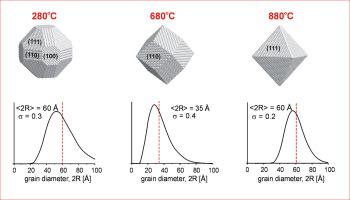当前位置:
X-MOL 学术
›
Diam. Relat. Mater.
›
论文详情
Our official English website, www.x-mol.net, welcomes your
feedback! (Note: you will need to create a separate account there.)
Atomic structure and grain shape evolution of nanodiamond during annealing in oxidizing atmosphere from neutron diffraction and MD simulations
Diamond and Related Materials ( IF 4.3 ) Pub Date : 2021-01-01 , DOI: 10.1016/j.diamond.2020.108177 Svitlana Stelmakh , Kazimierz Skrobas , Stanislaw Gierlotka , Sven C. Vogel , Bogdan Palosz
Diamond and Related Materials ( IF 4.3 ) Pub Date : 2021-01-01 , DOI: 10.1016/j.diamond.2020.108177 Svitlana Stelmakh , Kazimierz Skrobas , Stanislaw Gierlotka , Sven C. Vogel , Bogdan Palosz

|
Abstract Real space pair-distribution function (PDF) analysis in conjunction with molecular dynamics (MD) simulations was applied to characterize crystal structure, shape and surface structure of diamond nanoparticles annealed in air up to 880 °C. MD simulated models of individual nanodiamond particles of various shapes and sizes were used to calculate theoretical radial distribution functions G(r) for powders with different grain size distributions. The calculated curves, showing distinct differences for the explored parameter space, were compared to the experimental G(r) functions obtained from neutron scattering for annealed detonated nanodiamond samples in a search for a model best describing the actual powders. It was found that as-synthesized nanodiamond grains are terminated by equally abundant (100), (110) and (111) crystallographic faces and their structure does not change upon annealing in air up to 280 °C. The shape and size of grains annealed above 480 °C changes due to surface etching. The etching rate differs between crystals faces and depends on temperature, resulting in the observed differences in grain shape. Below 680 °C the share of the (110) facets gradually increases and at 680 °C the grains become rhombic dodecahedra terminated solely by (110) surfaces. Further increase of the annealing temperature promotes formation of (111) surfaces and at 880 °C the preferred grain shape becomes an octahedron terminated by a variant of (111) surfaces possessing three dangling sp3 bonds per atom. At lower temperatures all grains become smaller and the size distribution moves towards the lower values. As the annealing temperature increases, the smallest grains disappear entirely and the average grain size grows back.
中文翻译:

中子衍射和MD模拟在氧化气氛中退火过程中纳米金刚石的原子结构和晶粒形状演变
摘要 实际空间对分布函数 (PDF) 分析与分子动力学 (MD) 模拟相结合,用于表征在高达 880 °C 的空气中退火的金刚石纳米颗粒的晶体结构、形状和表面结构。各种形状和尺寸的单个纳米金刚石颗粒的 MD 模拟模型用于计算具有不同粒度分布的粉末的理论径向分布函数 G(r)。将计算出的曲线显示出探索参数空间的明显差异,并将其与从退火引爆纳米金刚石样品的中子散射获得的实验 G(r) 函数进行比较,以寻找最能描述实际粉末的模型。发现合成的纳米金刚石颗粒以同样丰富的 (100) 终止,(110) 和 (111) 晶面及其结构在空气中退火至 280 °C 时不会发生变化。由于表面蚀刻,在 480 °C 以上退火的晶粒的形状和尺寸会发生变化。晶体面之间的蚀刻速率不同并取决于温度,导致观察到的晶粒形状差异。在 680°C 以下,(110)面的份额逐渐增加,在 680°C 时,晶粒变成仅由(110)面终止的菱形十二面体。退火温度的进一步提高促进了 (111) 表面的形成,并且在 880°C 下,优选的晶粒形状变成了八面体,其末端是 (111) 表面的变体,每个原子具有三个悬空 sp3 键。在较低温度下,所有晶粒都变小,尺寸分布向较低值移动。随着退火温度的升高,
更新日期:2021-01-01
中文翻译:

中子衍射和MD模拟在氧化气氛中退火过程中纳米金刚石的原子结构和晶粒形状演变
摘要 实际空间对分布函数 (PDF) 分析与分子动力学 (MD) 模拟相结合,用于表征在高达 880 °C 的空气中退火的金刚石纳米颗粒的晶体结构、形状和表面结构。各种形状和尺寸的单个纳米金刚石颗粒的 MD 模拟模型用于计算具有不同粒度分布的粉末的理论径向分布函数 G(r)。将计算出的曲线显示出探索参数空间的明显差异,并将其与从退火引爆纳米金刚石样品的中子散射获得的实验 G(r) 函数进行比较,以寻找最能描述实际粉末的模型。发现合成的纳米金刚石颗粒以同样丰富的 (100) 终止,(110) 和 (111) 晶面及其结构在空气中退火至 280 °C 时不会发生变化。由于表面蚀刻,在 480 °C 以上退火的晶粒的形状和尺寸会发生变化。晶体面之间的蚀刻速率不同并取决于温度,导致观察到的晶粒形状差异。在 680°C 以下,(110)面的份额逐渐增加,在 680°C 时,晶粒变成仅由(110)面终止的菱形十二面体。退火温度的进一步提高促进了 (111) 表面的形成,并且在 880°C 下,优选的晶粒形状变成了八面体,其末端是 (111) 表面的变体,每个原子具有三个悬空 sp3 键。在较低温度下,所有晶粒都变小,尺寸分布向较低值移动。随着退火温度的升高,











































 京公网安备 11010802027423号
京公网安备 11010802027423号